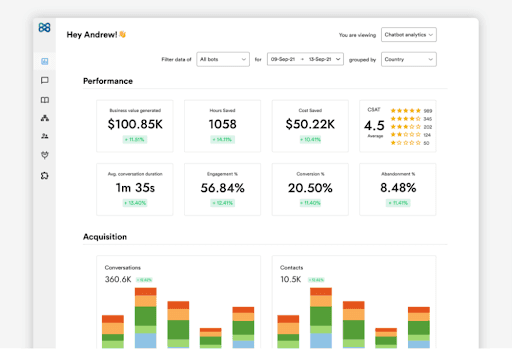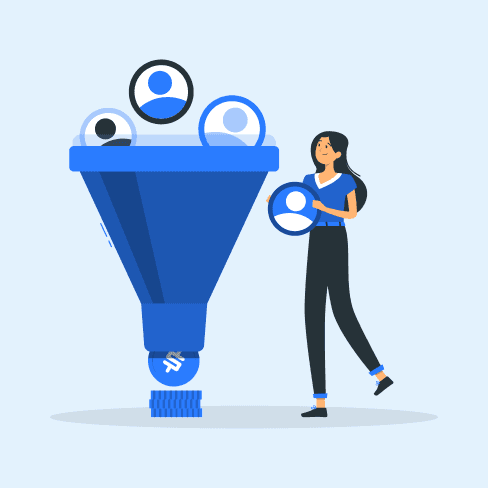Lead Generation /
7 Min read
9 Things to Look For in a Lead Generation Chatbot
November 7, 2022

Bhavyadeep Sinh Rathod
Content Editor, WotNot
Ask any brand today why they want to deploy a chatbot and you’ll get two prominent answers - Lead generation and customer support.
Chatbots are one of the most effective strategies for lead generation and an integral part of the marketing automation arsenal.
55% of businesses are already generating high-quality leads through chatbots since they collect information round the clock, throughout the year.
However, for lead generation chatbots to work their magic, they need to be built strategically after taking into account numerous considerations.
Because after coming to a decision of implementing a chatbot, getting everyone on board, and choosing the perfect chatbot pricing model, you want things to go the right way and yield the best results.
So instead of straightaway deploying your chatbot for lead generation, check out some of the must-haves that you need to follow.
1. A No-Code Platform
When you’re looking into a long-term solution for demand generation, you need to ensure convenience and agility. For chatbots, no code is the answer.
Why?
Because, as the name suggests, one doesn’t have to be a software developer or a coder to build a chatbot. No-code bot builder allows anyone to build and deploy bots through a drag-and-drop interface.
You’d really appreciate this feature, when your marketing team wants to make minor tweaks to the script, make major edits, and change the entire flow, all without the help of a developer.
Since most blocks would be available on the platform, your development team can focus on core business features and developing integrations that enhance chatbot performance and offer a competitive advantage.
It also helps you align your business requirements with chatbot outputs and it’s a blessing since strategic needs often get lost in communication gaps between businesses and technology teams.
No-code chatbot platforms have cross-functional participation that makes it easier to align customer expectations and the needs of the business. It simplifies the hardest part of building a chatbot and helps you quickly reap the benefits of the technology.
Because, as the name suggests, one doesn’t have to be a software developer or a coder to build a chatbot. No-code bot builder allows anyone to build and deploy bots through a drag-and-drop interface. Here is a quick video that shows how you can create a lead generation chatbot on a no-code platform in a matter of few minutes.
2. Plan Lead Journey
Regardless of the type of bot you're building, one thing that is consistent throughout all chatbot implementations is the scripting process that is done while keeping the lead journey in mind.

Ask yourself, what is the conversational flow you want your customers to take? How you design the conversational flow largely defines the type of journey your leads will have and how they will behave.
You already know that all your leads can fall into the top of the funnel, middle of the funnel, and bottom of the funnel. And all types of leads may interact with your chatbot at different stages.
But you cannot have the same type of conversation with each lead. You cannot direct a lead at an awareness stage to the pricing page or a bottom-of-the-funnel lead to check out a blog.
Ensure that your chatbot script facilitates different flows for each type of lead. Add buttons through which leads have options to choose how they want to interact with the bot.
Your bot can provide information to top-of-the-funnel leads, provide examples to the middle of the funnel, and provide quotations to the bottom-of-the-funnel leads. Only if you optimize and personalize chatbot strategies for every stage rather than going for a one-flow-for-all approach, you can expect results.
3. Clear Definition of the Information That Bot Will Capture
For different industries, lead generation will have different definitions.
Ask yourself, “What constitutes a lead for you?"
For example, a SaaS company will capture names, contact numbers, and business email IDs. A salon or a real estate agency will capture leads through appointments and site visits, an eCommerce company will capture the name, contact information, location, and personal email addresses, etc.
The list goes on.
What qualifies as a lead and what information you want to capture depends on your industry and also your objectives. But they need to clearly reflect in your chatbot for lead generation. When you build your lead generation chatbot, ensure that you obtain your lead information.
Some things you need to take care of are:
a. Choose Variable
While designing a lead generation chatbot on a bot builder, you’ll need to ensure users provide accurate lead information. For example, on WotNot’s bot-builder, you can click on input validation that checks if the user has provided a name, the phone number consists of ten digits, and the email address follows the ‘_’ and ‘.com’ format.
b. Adding Success and Failure Messages
For every information captured by the bot, add a success or a failure message. WotNot’s app recognizes when a user doesn’t input a valid phone number or an email address.
4. A Welcoming Message
A welcoming message will ultimately decide whether or not the user will interact with you. Regardless of how interactive your flow is if the welcome message fails to make an impression, the chatbot will fail to generate leads.
Chatbot conversations are all about proactive messaging. You need to lure the users to interact with the bot through compelling and crisp copies. Some ways you can follow are:
a. Notification Sound
A user may miss the chat bubble on the site or other platforms. You can add a ding sound to remind them to interact with the bot while browsing. It can also direct the user to land back on the web page if they are browsing elsewhere.
b. Popup
Just like a sound, a popup can also work wonders for proactive engagement. A chat popup needs to have funny or relatable content that prompts users to open that chat interface and have a conversation with the bot.
For example, WotNot has included a pop culture GIF that resonates with the user. Along with the GIF, the copy straightaway jumps to the customer pain points like “Can we help you increase demand or automate support?” It is a great way for the bot to build rapport with prospects and sets the tone for the bot from the beginning.

5. Defined Tone of Voice
You define the tone from the first message. Your brand already has a voice. For example, notice that Nike’s voice is inspirational, Starbucks’ voice is expressive, and MailChimp’s voice is genuine with a touch of dry humor. Depending on your positioning, your brand can also have a voice implemented throughout your campaigns, social media, and content.
When you leverage a lead generation chatbot, you need to instill the same brand values, perception, and tone while you prepare the script. The only difference is, the script needs to be conversational. You can take various roads in defining the tone. It can be:
Professional
Formal
Informal
Millennial
Humorous
Inspirational
But regardless of the tone you use, the chatbot should fulfill its purpose of being helpful to the customer and generating leads for you. You also need to get creative here. Because on other mediums, the communication isn’t two-way.
Your tone needs to be welcoming because the customer will interact with you too in real time. Sure, you have to stay consistent on all platforms. But on chatbots, flexibility is the key to acing lead generation conversations.
6. Rich Media Components

The idea of a chatbot stems from having an instant messaging medium where businesses can chat with customers at their time and place of convenience. Think of how you would chat with a friend or family on Messenger or WhatsApp.
The conversations would have a humane touch. In between texts you share GIFs or images that convey your mood better.
Although chatbots for lead generation don’t have to look exactly the same as they do on personal messaging platforms, it is a useful chatbot marketing strategy to add flavor to mundane conversations.
A picture can convey a lot more than text. At the same time, they can also reflect your brand personality and tone. Adding pictures, emojis, and GIFs can play a vital role in grasping visitors’ attention.
A lot of brands are also leveraging chatbot carousels to compress messages and avoid text-heavy interfaces. The idea isn’t to shred the professional decorum but to adapt to the nature of the medium. Think of how you position yourself on social media versus your website.
Similarly, think of your lead gen chatbot as an informal messaging platform that calls for integrating rich media components. However, remember to strike a balance. Too many images and emojis can also lead to customers not asking you seriously and failing to generate leads. Up to two elements per message is usually an acceptable range.
7. CRM Integration
Your CRM is the vessel that contains all the leads you generate. As you generate leads on a chatbot, you don’t have to manually add every lead into the CRM. The whole marketing automation ecosystem relies on integrations to make regular tasks easier and automated.
If you’re deploying a lead gen chatbot, you need to integrate your chatbot with your existing CRM. That will ensure that all your leads are automatically consolidated in the right place.
A pro tip would be to check if your chatbot provider provides integration with your existing CRM. If not, you’d have to inquire about native integrations. As a brand, you want to capture leads your way, ask for the information you need, and add it to a CRM of your choice.
Fortunately, if you build a chatbot on WotNot, it can integrate your bot into any custom CRM as long as they have an API available.
8. Scheduling Integrations

For a lot of industries, the leads generated are equal to the appointments scheduled to demos booked. Businesses spend ample time collecting information about potential customers. Mediums like calls and emails are outdated because of inconvenience and manual labor.
Lead generation chatbot can promptly do this task by integrating a calendar on the chat interface itself. Instead of going through the process of booking appointments on call, bots can ask questions and allow customers to schedule appointments by naturally asking questions.
If a user wants to schedule appointments or book a demo, they can simply choose a date and time of their preference, and your bot can automatically generate leads and record the same in the CRM.
9. KPIs for Performance Tracking
The performance of a lead generation chatbot isn’t just measured by how many leads you generate. You need to get a detailed review of how you can improve the bot based on the conversational length and conversion rate.
The first thing you have to do is define your KPIs. For a lead gen chatbot, the KPIs can range from the number of leads generated, the amount of business value generated, the conversion rate, and the engagement rate.
The best way to gauge the performance would be to review the chatbot analytics dashboard. WotNot’s analytics dashboard provides you with a birds eye’s view of the bot's performance.
It automatically generates the numbers in terms of the business value, engagement rate, and conversion rate, based on the number of leads the bot generates.

Once you get the desired numbers, you get a better understanding of where your bot needs changes. For example, if the conversion rate is low, you need to add sound and popup notifications, if the conversation abandonment rate is high, you need to make changes to the flow, and so on.
Finishing Thoughts
While a lot has been said about the “why” aspect of lead-generation chatbots sealing the deal for marketers and business owners in generating value, it is essential to understand the layers that define the “how” aspect too.
Without intricate planning, deploying chatbots for lead generation would barely fetch you results. Hence, ensure the above-mentioned must-haves before you launch.
WotNot has experience in deploying successful lead-generation chatbots for notable brands. In case you want to follow suit and need assistance, you can get in touch with us, and we’ll be happy to help and educate you on how a lead generation bot can change the trajectory of your business.
ABOUT AUTHOR
Bhavyadeep Sinh Rathod
Content Editor, WotNot
He likes technology, chatbots, comedy, philosophy, and sports. He often cracks hilarious jokes and lightens everyone's mood in the team.



